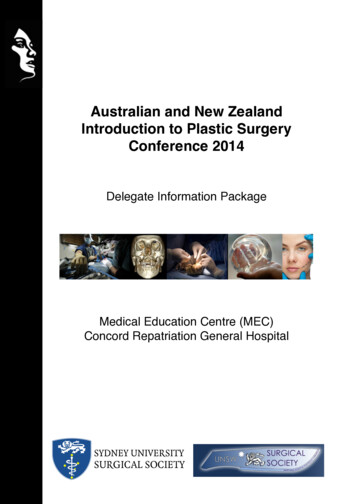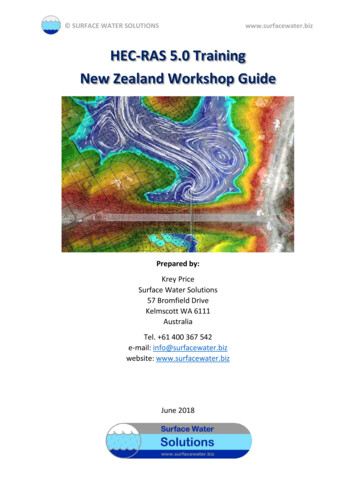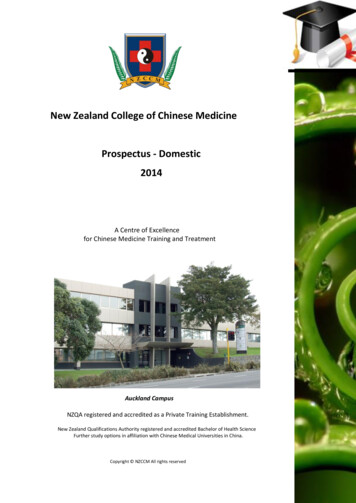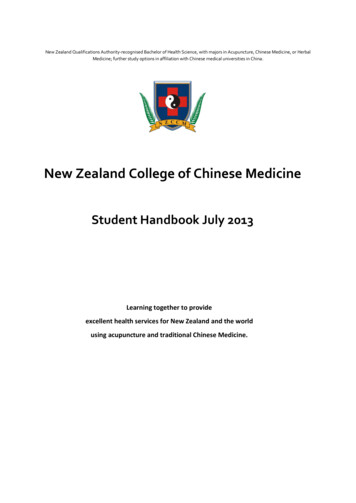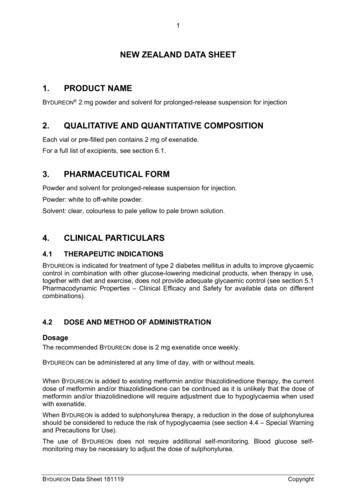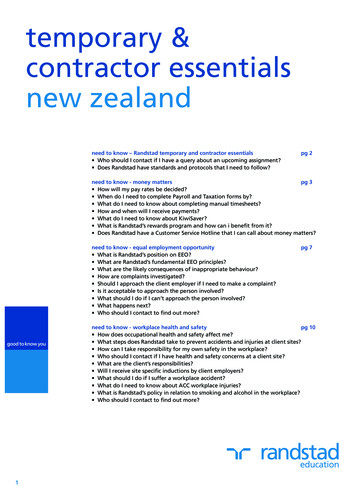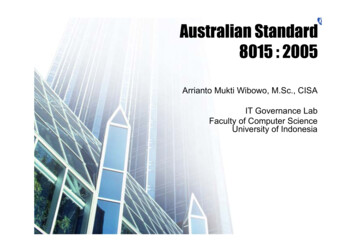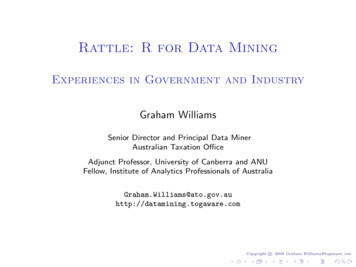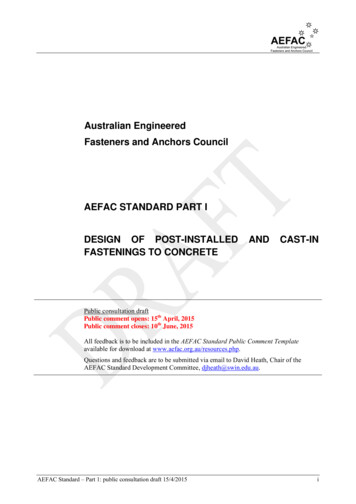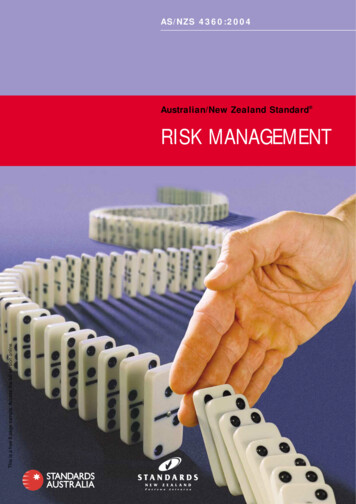
Transcription
AS/NZS 4360:2004Australian/New Zealand Standard This is a free 8 page sample. Access the full version online.RISK MANAGEMENT
This is a free 8 page sample. Access the full version online.Risk managementAS/NZS 4360:2004
This Joint Australian/New Zealand Standard was prepared by Joint TechnicalCommittee OB-007, Risk Management. It was approved on behalf of the Council ofStandards Australia on 21 July 2004 and on behalf of the Council of Standards NewZealand on 20 August 2004.This Standard was published on 31 August 2004.The following are represented on Committee OB-007:Australian Computer SocietyAustralian Customs ServiceAustralia New Zealand Institute of Insurance and FinanceCSIRO (Commonwealth Scientific and Industrial Research Organisation)Department of Defence (Australia)Department of Finance and AdministrationEmergency Management AustraliaEnvironmental Risk Management Authority (New Zealand)Institute of Chartered Accountants (Australia)Institution of Engineers AustraliaInstitution of Professional Engineers New ZealandLocal Government New ZealandMassey University (New Zealand)Minerals Council of AustraliaMinistry of Agriculture and Forestry (New Zealand)Ministry of Economic Development (New Zealand)NSW Treasury Managed FundNew Zealand Society for Risk ManagementRisk Management Institution of AustralasiaSafety Institute of AustraliaSecurities Institute of AustraliaUniversity of New South WalesVictorian WorkCover AuthorityWater Services Association of AustraliaThis Standard was issued in draft form for comment as DR 03360.Originated as AS/NZS 4360:1995.Second edition 1999.Third edition 2004Keeping Standards up-to-dateThis is a free 8 page sample. Access the full version online.Standards are living documents which reflect progress in science, technology and systems. To maintaintheir currency, all Standards are periodically reviewed, and new editions are published. Betweeneditions, amendments may be issued. Standards may also be withdrawn. It is important that readersassure themselves they are using a current Standard, which should include any amendments which mayhave been published since the Standard was purchased.Detailed information about joint Australian/New Zealand Standards can be found by visiting theStandards Web Shop at www.standards.com.au or Standards New Zealand web site atwww.standards.co.nz and looking up the relevant Standard in the on-line catalogue.Alternatively, both organizations publish an annual printed Catalogue with full details of all currentStandards. For more frequent listings or notification of revisions, amendments and withdrawals,Standards Australia and Standards New Zealand offer a number of update options. For informationabout these services, users should contact their respective national Standards organization.We also welcome suggestions for improvement in our Standards, and especially encourage readers tonotify us immediately of any apparent inaccuracies or ambiguities. Please address your comments tothe Chief Executive of either Standards Australia International or Standards New Zealand at theaddress shown on the back cover.ISBN 0 7337 5904 1 Standards Australia/Standards New ZealandAll rights are reserved. No part of this work may be reproduced or copied in anyform or by any means, electronic or mechanical, including photocopying, withoutthe written permission of the publisher.Jointly published by Standards Australia International Ltd, GPO Box 5420, Sydney,NSW 2001 and Standards New Zealand, Private Bag 2439, Wellington 6020.
AS/NZS 4360:2004Risk managementPrefaceThis Standard was prepared by the Joint Standards Australia/Standards New Zealand Committee OB-007, Risk Managementas a revision of AS/NZS 4360:1999, Risk management. Itprovides a generic framework for establishing the context,identifying, analysing, evaluating, treating, monitoring andcommunicating risk.This revised Standard incorporates the insights gained throughthe application of the 1999 edition, and current thinking on riskmanagement.Some of the changes from the 1999 edition include— greater emphasis on the importance of embedding riskmanagement practices in the organization’s culture andprocesses; greater emphasis on the management of potential gains aswell as potential losses; and moving and expanding indicative examples into a newhandbook.HB 436, Risk Management Guidelines—Companion toAS/NZS 4360:2004 contains specific guidance on theimplementation of the Standard. The two documents areintended to be used together.This is a free 8 page sample. Access the full version online.In addition, Standards Australia and Standards New Zealandhave published a range of handbooks on the way the riskmanagement process can be applied in a variety of sectors and arange of subject areas.iii
AS/NZS 4360:2004Risk managementContents1 Scope and general . 11.1 Scope and application . 11.2 Objective . 11.3 Definitions . 21.4 Terminology and translation . 61.5 Referenced documents . 62 Risk management process overview . 72.1 General . 72.2 Main elements. 73 Risk management process . 113.1 Communicate and consult. 113.2 Establish the context . 123.3 Identify risks. 163.4 Analyse risks . 163.5 Evaluate risks. 193.6 Treat risks . 20This is a free 8 page sample. Access the full version online.3.7 Monitor and review. 223.8 Record the risk management process . 234 Establishing effective risk management . 254.1 Purpose . 254.2 Evaluate existing practices and needs . 254.3 Risk management planning . 26iv
AS/NZS 4360:2004Risk managementForewordRisk management involves managing to achieve an appropriatebalance between realizing opportunities for gains whileminimizing losses. It is an integral part of good managementpractice and an essential element of good corporate governance.It is an iterative process consisting of steps that, whenundertaken in sequence, enable continuous improvement indecision-making and facilitate continuous improvement inperformance.Risk management involves establishing an appropriateinfrastructure and culture and applying a logical and systematicmethod of establishing the context, identifying, analysing,evaluating, treating, monitoring and communicating risksassociated with any activity, function or process in a way thatwill enable organizations to minimize losses and maximizegains.To be most effective, risk management should become part of anorganization's culture. It should be embedded into theorganization's philosophy, practices and business processesrather than be viewed or practiced as a separate activity. Whenthis is achieved, everyone in the organization becomes involvedin the management of risk.Although the concept of risk is often interpreted in terms ofhazards or negative impacts, this Standard is concerned with riskas exposure to the consequences of uncertainty, or potentialdeviations from what is planned or expected. The processdescribed here applies to the management of both potential gainsand potential losses.This is a free 8 page sample. Access the full version online.Organizations that manage risk effectively and efficiently aremore likely to achieve their objectives and do so at lower overallcost.v
AS/NZS 4360:2004Risk managementThis is a free 8 page sample. Access the full version online.This page has been left blank intentionallyvi
AS/NZS 4360:2004Risk management1 Scope and general1.1 Scope and applicationThis Standard provides a generic guide for managing risk. ThisStandard may be applied to a very wide range of activities,decisions or operations of any public, private or communityenterprise, group or individual. While the Standard has verybroad applicability, risk management processes are commonlyapplied by organizations or groups and so, for convenience, theterm ‘organization’ has been used throughout this Standard.This Standard specifies the elements of the risk managementprocess, but it is not the purpose of this Standard to enforceuniformity of risk management systems. It is generic andindependent of any specific industry or economic sector. Thedesign and implementation of the risk management system willbe influenced by the varying needs of an organization, itsparticular objectives, its products and services, and the processesand specific practices employed.This is a free 8 page sample. Access the full version online.This Standard should be applied at all stages in the life of anactivity, function, project, product or asset. The maximumbenefit is usually obtained by applying the risk managementprocess from the beginning. Often a number of discrete studiesare carried out at different times, and from strategic andoperational perspectives.The process described here applies to the management of bothpotential gains and potential losses.1.2 ObjectiveThe objective of this Standard is to provide guidance to enablepublic, private or community enterprises, groups and individualsto achieve— a more confident and rigorous basis for decision-making andplanning; better identification of opportunities and threats; gaining value from uncertainty and variability;CopyrightScope and general1
This is a free 8 page sample. Access the full version online.AS/NZS 4360:2004 Risk managementThe remainder of this documentis available for purchase online atwww.saiglobal.com/shopSAI Global also carries a wide range of publications from a wide variety of Standards Publishers:Click on the logos to search the database online.
AS/NZS 4360:2004 Risk management iii Preface This Standard was prepared by the Joint Standards Australia/ Standards New Zealand Committee OB-007, Risk Management as a revision of AS/NZS 4360:1999, Risk management. It provides a generic framework for establishing the context, identifying, analysing, evaluating, treating, monitoring and
